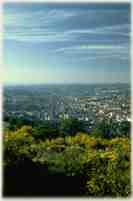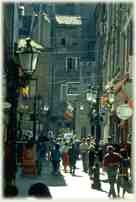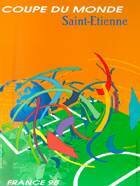
The Bold "Green" City
A city rich in skills inherited from its industrial past, Saint-Etienne ranks today as the second largest urban conglomeration in the Rhône-Alpes region. With its ambition to conduct extensive economic projects, the city is banking on the World Football Cup to demonstrate its vitality and know-how.
Birthplace of the industrial era
 aint-Etienne started booming right back in the 16th century, becoming prosperous through the manufacture of furnishing trimmings and weapons. Then, in the 19th century, the city really began to build its industrial reputation, largely through coal-mining, and the industrial revolution turned Saint-Etienne into one of France's leading cities. The famous "Ecole des Mines" (national school of mine engineering) was founded there in 1816, and it is no coincidence that France's first railway line had a terminus in Saint-Etienne in 1827. In the mid 19th century, the city prudently began to diversify its activities and develop new industries. It was then that the mass-distribution specialist Perrachon, today known as "CASINO," was founded, as well as the famous "Manufrance" company selling arms and cycles. Coal-mining was at its peak. With the 20th century emerged new economic models: the leisure industry was born, and .Saint-Etienne built its theatre, stadium and museums. Building on its past heritage, the Saint-Etienne of the year 2000 is developing by adjusting to the new demands of the present. aint-Etienne started booming right back in the 16th century, becoming prosperous through the manufacture of furnishing trimmings and weapons. Then, in the 19th century, the city really began to build its industrial reputation, largely through coal-mining, and the industrial revolution turned Saint-Etienne into one of France's leading cities. The famous "Ecole des Mines" (national school of mine engineering) was founded there in 1816, and it is no coincidence that France's first railway line had a terminus in Saint-Etienne in 1827. In the mid 19th century, the city prudently began to diversify its activities and develop new industries. It was then that the mass-distribution specialist Perrachon, today known as "CASINO," was founded, as well as the famous "Manufrance" company selling arms and cycles. Coal-mining was at its peak. With the 20th century emerged new economic models: the leisure industry was born, and .Saint-Etienne built its theatre, stadium and museums. Building on its past heritage, the Saint-Etienne of the year 2000 is developing by adjusting to the new demands of the present.

A successful conversion
 ormer capital of the arms, fashion accessory and cycle industries, Saint-Etienne has rapidly built up a reputation for its expertise in sub-contracting and mechanics. Today, close to 400 small and medium-size businesses, grouped in industrial "poles" (including industrial automation, medical technologies and optical engineering) make up the city's economic fabric and provide its driving force. With top-class higher education institutions (Ecole des Mines, and colleges for fine arts and architecture), the city is also home to 700 researchers and is a major venue for scientific conventions. ormer capital of the arms, fashion accessory and cycle industries, Saint-Etienne has rapidly built up a reputation for its expertise in sub-contracting and mechanics. Today, close to 400 small and medium-size businesses, grouped in industrial "poles" (including industrial automation, medical technologies and optical engineering) make up the city's economic fabric and provide its driving force. With top-class higher education institutions (Ecole des Mines, and colleges for fine arts and architecture), the city is also home to 700 researchers and is a major venue for scientific conventions.
The city of art and culture
 nown in the past for the expertise of its craftsmen, Saint-Etienne is now a lively artistic centre. A large number of shows are held every season at the Comédie Jean Dasté and the Esplanade Opera House. The Modern Art Museum houses the second largest public collection of French contemporary art, after Paris. The Museum of Art and Industry is about to receive a unique collection of weapons, while the Coal-mining Museum and the Planetarium, among others, constitute cultural landmarks in a city that also welcomes nearly 400 authors every year at the Book Fair. nown in the past for the expertise of its craftsmen, Saint-Etienne is now a lively artistic centre. A large number of shows are held every season at the Comédie Jean Dasté and the Esplanade Opera House. The Modern Art Museum houses the second largest public collection of French contemporary art, after Paris. The Museum of Art and Industry is about to receive a unique collection of weapons, while the Coal-mining Museum and the Planetarium, among others, constitute cultural landmarks in a city that also welcomes nearly 400 authors every year at the Book Fair.
An exceptional environment to live in
 ut Saint-Etienne is also known for its natural environment, and has received much acclaim for its quality of life. With 60,000 hectares of protected green areas, the region offers a wide range of outdoor activities for nature buffs. ut Saint-Etienne is also known for its natural environment, and has received much acclaim for its quality of life. With 60,000 hectares of protected green areas, the region offers a wide range of outdoor activities for nature buffs.

Saint-Etienne IN THE RUN-UP TO THE WORLD CUP
From the very outset, Saint-Etienne grasped the importance of hosting the Football World Cup in 1998, and was quick to involve its whole population, making the success of the event a goal for everyone.
Living the World Cup
 he first symbol of this goal has been the founding of an association entirely devoted to preparing for the big event: thanks to SECOM (Saint-Etienne Coupe du Monde), the whole city lives and breathes the World Cup. The countdown has already started, as evinced by three giant clocks, placed at the gates of the city and along the highways, that are measuring the time left before Saint-Etienne welcomes the games. At 365 days before kick-off, this is truly "a countdown that counts": this was the message in the city's press campaign, where it stressed its determination to mobilise the entire population to ensure the success of FRANCE 98. he first symbol of this goal has been the founding of an association entirely devoted to preparing for the big event: thanks to SECOM (Saint-Etienne Coupe du Monde), the whole city lives and breathes the World Cup. The countdown has already started, as evinced by three giant clocks, placed at the gates of the city and along the highways, that are measuring the time left before Saint-Etienne welcomes the games. At 365 days before kick-off, this is truly "a countdown that counts": this was the message in the city's press campaign, where it stressed its determination to mobilise the entire population to ensure the success of FRANCE 98.
Image-building...
 ooking beyond its regional borders, Saint-Etienne has also embarked on a billboard campaign in six French cities, with a view to enhancing its image and restoring its reputation as a city of grandeur and excellence. ooking beyond its regional borders, Saint-Etienne has also embarked on a billboard campaign in six French cities, with a view to enhancing its image and restoring its reputation as a city of grandeur and excellence.
Know-how
 he city is proving highly creative in the run-up to 1998, as highlighted by the operation conducted the day before renovation work started on the Geoffroy Guichard stadium: the old pitch was cut up and offered to the football club's supporters, enabling them to take home a piece of the "sacred turf." About five weeks before the World Cup kick-off, Saint-Etienne's citizens will be invited to share a moving moment, with a huge show organised for the inauguration of the new stadium. he city is proving highly creative in the run-up to 1998, as highlighted by the operation conducted the day before renovation work started on the Geoffroy Guichard stadium: the old pitch was cut up and offered to the football club's supporters, enabling them to take home a piece of the "sacred turf." About five weeks before the World Cup kick-off, Saint-Etienne's citizens will be invited to share a moving moment, with a huge show organised for the inauguration of the new stadium.
And for those who can't wait until 1998, Saint-Etienne promises to rise to the occasion. A village set up in the downtown area is to host a permanent celebration, with activities, meetings with well-known personalities, and exclusive shows, while the city's neighbourhoods will dress up in the colours of the qualifying countries, as impressive parades file down the main streets, bringing a feeling of cheerfulness and fun to everybody's hearts.
|
POPULATION
Inner city:
200,000 habitants
Urban area:
450,000 habitants
Mayor: Jean-Michel Thiollière
THE CLUB
A.S. Saint-Etienne
10 French league titles
6 times French Cup winners
TOURISM
Sites and monuments
History
Trips
Economy
CITY LIFE
Weather
Going out
Good Idea
Staying
MAPS
City map
Stadium location
Itineraries
|











